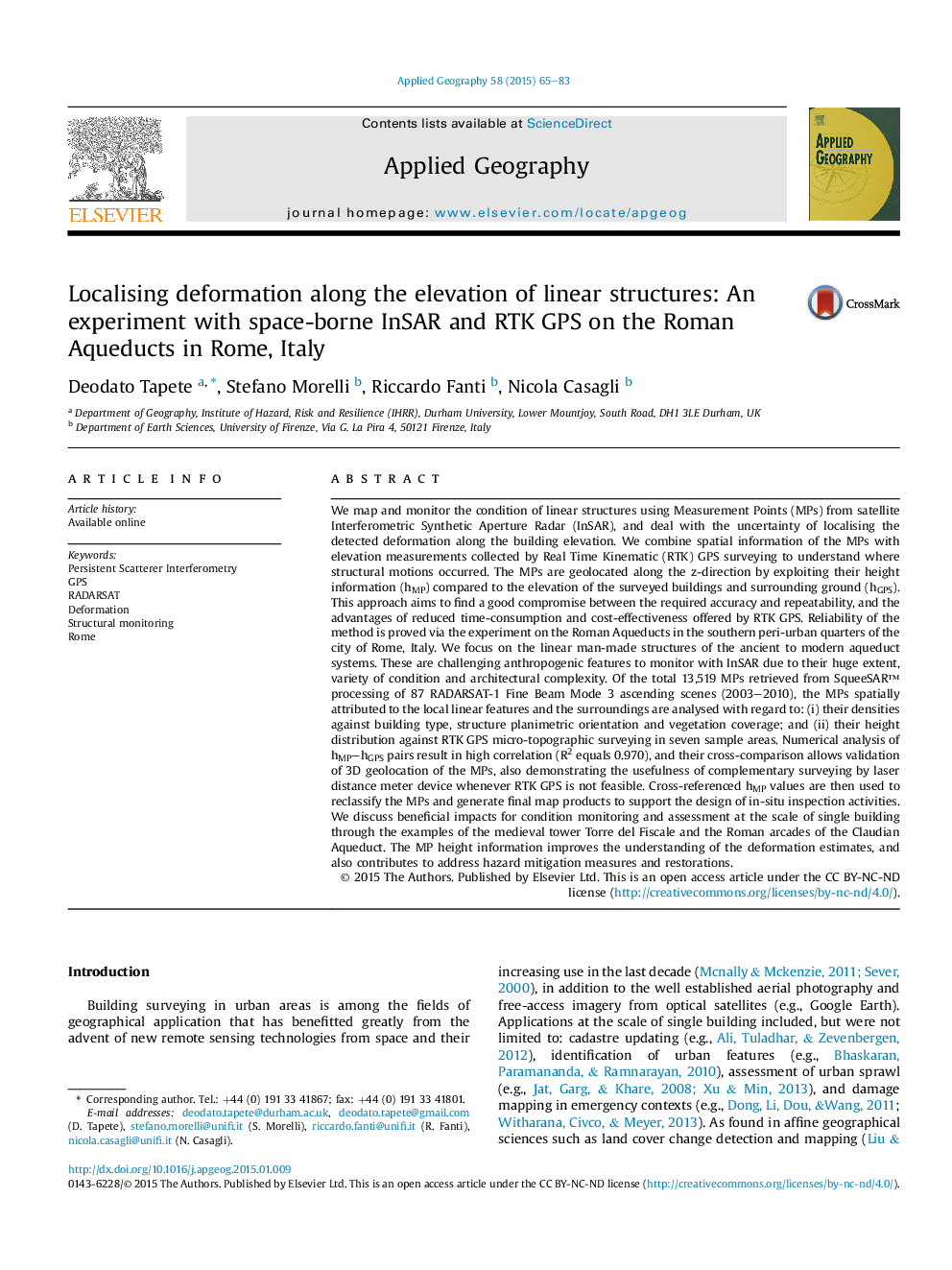| کد مقاله | کد نشریه | سال انتشار | مقاله انگلیسی | نسخه تمام متن |
|---|---|---|---|---|
| 6538593 | 158705 | 2015 | 19 صفحه PDF | دانلود رایگان |
عنوان انگلیسی مقاله ISI
Localising deformation along the elevation of linear structures: An experiment with space-borne InSAR and RTK GPS on the Roman Aqueducts in Rome, Italy
دانلود مقاله + سفارش ترجمه
دانلود مقاله ISI انگلیسی
رایگان برای ایرانیان
کلمات کلیدی
موضوعات مرتبط
علوم زیستی و بیوفناوری
علوم کشاورزی و بیولوژیک
جنگلداری
پیش نمایش صفحه اول مقاله

چکیده انگلیسی
We map and monitor the condition of linear structures using Measurement Points (MPs) from satellite Interferometric Synthetic Aperture Radar (InSAR), and deal with the uncertainty of localising the detected deformation along the building elevation. We combine spatial information of the MPs with elevation measurements collected by Real Time Kinematic (RTK) GPS surveying to understand where structural motions occurred. The MPs are geolocated along the z-direction by exploiting their height information (hMP) compared to the elevation of the surveyed buildings and surrounding ground (hGPS). This approach aims to find a good compromise between the required accuracy and repeatability, and the advantages of reduced time-consumption and cost-effectiveness offered by RTK GPS. Reliability of the method is proved via the experiment on the Roman Aqueducts in the southern peri-urban quarters of the city of Rome, Italy. We focus on the linear man-made structures of the ancient to modern aqueduct systems. These are challenging anthropogenic features to monitor with InSAR due to their huge extent, variety of condition and architectural complexity. Of the total 13,519 MPs retrieved from SqueeSAR⢠processing of 87 RADARSAT-1 Fine Beam Mode 3 ascending scenes (2003-2010), the MPs spatially attributed to the local linear features and the surroundings are analysed with regard to: (i) their densities against building type, structure planimetric orientation and vegetation coverage; and (ii) their height distribution against RTK GPS micro-topographic surveying in seven sample areas. Numerical analysis of hMP-hGPS pairs result in high correlation (R2 equals 0.970), and their cross-comparison allows validation of 3D geolocation of the MPs, also demonstrating the usefulness of complementary surveying by laser distance meter device whenever RTK GPS is not feasible. Cross-referenced hMP values are then used to reclassify the MPs and generate final map products to support the design of in-situ inspection activities. We discuss beneficial impacts for condition monitoring and assessment at the scale of single building through the examples of the medieval tower Torre del Fiscale and the Roman arcades of the Claudian Aqueduct. The MP height information improves the understanding of the deformation estimates, and also contributes to address hazard mitigation measures and restorations.
ناشر
Database: Elsevier - ScienceDirect (ساینس دایرکت)
Journal: Applied Geography - Volume 58, March 2015, Pages 65-83
Journal: Applied Geography - Volume 58, March 2015, Pages 65-83
نویسندگان
Deodato Tapete, Stefano Morelli, Riccardo Fanti, Nicola Casagli,